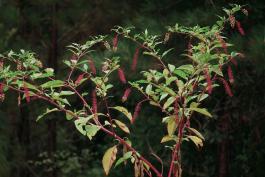
Pokeweed is a tall, smooth, branching perennial with red stems and juicy, dark purple berries. Stems smooth, often reddish- or purplish-tinged. Flowers in terminal and lateral racemes, minute, somewhat bell-shaped, with 5 greenish-white sepals suffused with pink. There are no petals, 10 protruding stamens, and 1 pistil with 10 carpels (chambers) in a ring, each carpel having its own style. Blooms May–October. Leaves many, alternate, smooth, oblong-lanceolate, to 1 foot long, on petioles. Fruit elongated clusters dark purple, juicy berries containing 10 oval black seeds.
Height: to 10 feet.

Statewide.
Habitat and Conservation
Common in disturbed soils and waste places, farmyards, fencerows, fields, and rights-of-way, and banks of waterways, ponds, lakes, bases and ledges of bluffs, and edges of bottomland and moist upland forests. Its handsome smooth, purple-tinged stems, stout taproot, and long-lasting fertility of the seeds make this a familiar, hardy weed. It is native to the eastern United States but has been introduced west to California and Oregon and to the Old World.
Status
The toxins in pokeweed are not completely understood. All parts should be considered poisonous to people and livestock. Cooking reduces the toxicity. Some people develop a rash after handling the plants. This is the only member of the pokeweed family in Missouri. Botanists, using gene sequencing data, are debating how big the pokeweed family is. It could contain between 30 and 120 species worldwide. Regardless, most pokeweed species live in tropical and subtropical regions of the New World.
Human Connections
All parts are toxic, but young shoots and leaves, after thorough cooking in at least 2 waters, are eaten by many in a dish traditionally called poke salat. This this plant is both toxic and edible. The berries have been used for food coloring, ink, and dye. Scientists are studying the plant for possible antiviral and antitumor medicine.
Ecosystem Connections
The berries are eaten by birds, which seem to be immune to the toxins in the fruits, and other animals. Birds disperse the seeds, which can survive in the soil for more than 40 years. Pokeweed is an aggressive and efficient colonizer of disturbed sites.

































